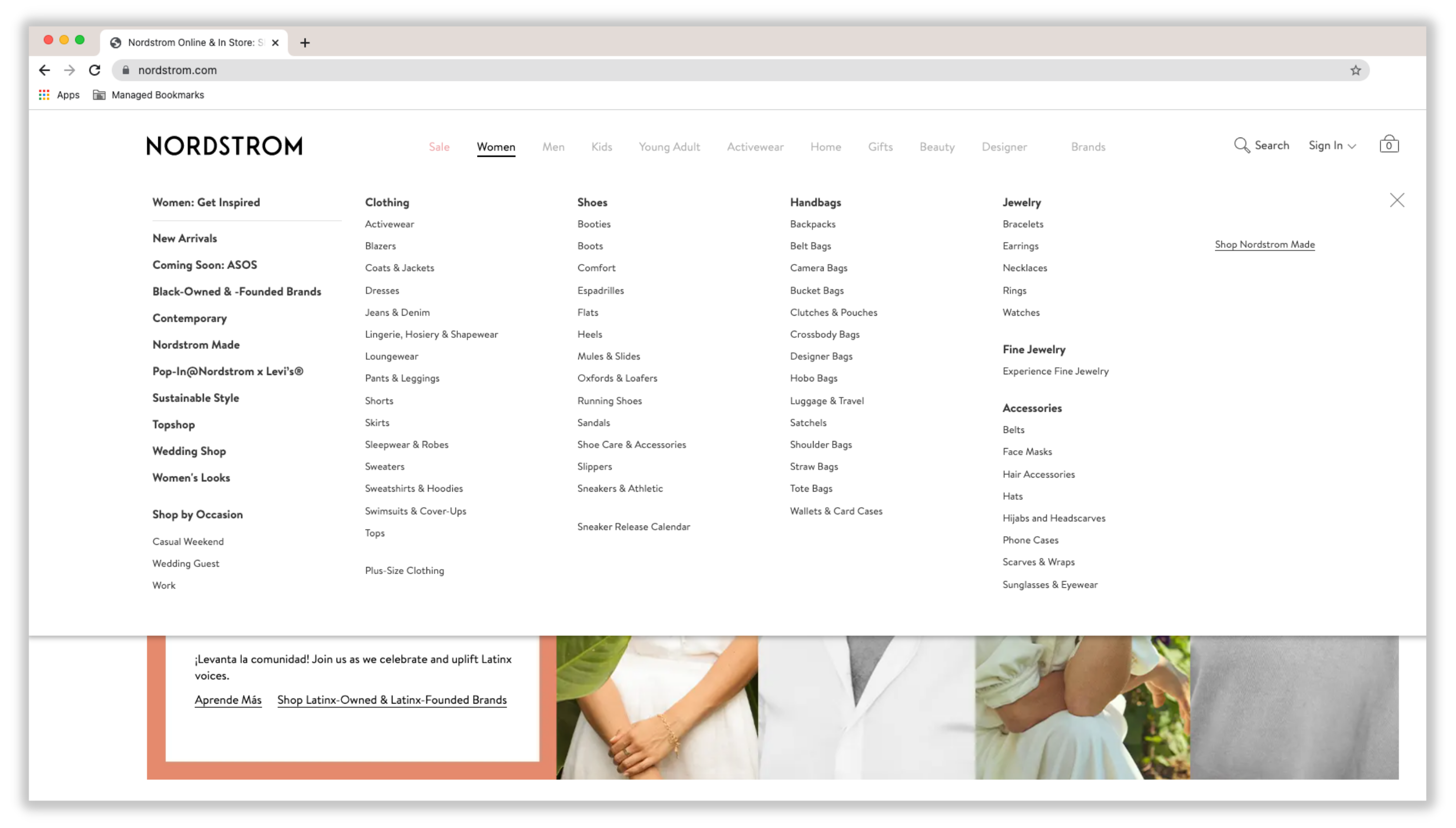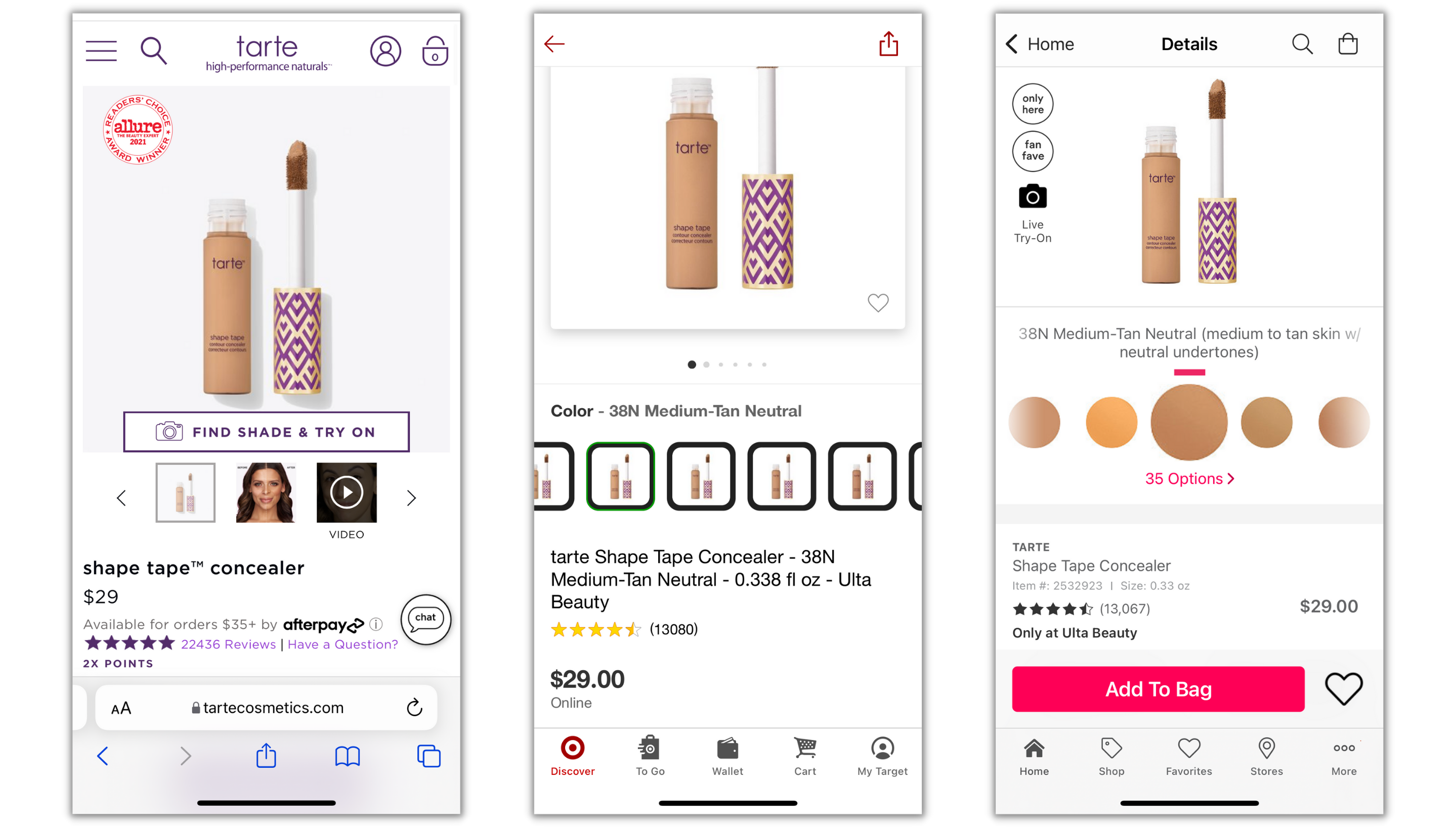Picture this: your local grocery store stops organizing food into categories.
The bananas are next to the baking soda. The canned peaches are near the pasta noodles. The frozen foods are slowly melting on the floor. It’s confusing, inefficient, and complete chaos.
Grocery stores are designed to optimize traffic flow with organized product groupings and easy-to-read labels. Retailers take a similar approach in e-commerce by creating intuitive product catalogs to guide shoppers through the buying process.
But maintaining a large product portfolio isn’t easy, and brands often struggle to create a cohesive experience across sales channels. To combat this, retailers turn to catalog management software to make adding, modifying, and distributing product information as simple as possible.
Definition of catalog management in e-commerce
In e-commerce, catalog management refers to the strategic process of organizing and distributing consistent product information across sales channels. Retailers use catalog management software to streamline the process of updating their product catalogs.
Consumers want a positive shopping experience on and offline. In fact, 50% of consumers would switch to a new brand after just one negative experience. Retailers simply can’t risk a bad user experience due to poor product catalog management.
Catalog management in e-commerce
Consumers spend a lot of time and effort conducting pre-purchase research and using search engines to explore their various solutions. The average user spends more than 11 minutes on google.com and views almost nine pages per visit.
A well-managed digital catalog is critical for modern retailers to meet consumers on their favorite platforms. This means it’s critical for retailers to establish trust with their buyers by making their product offerings as accessible as possible.
Product catalogs help improve the e-commerce shopping experience by providing all of the details buyers need to make a purchase decision, including product features, pricing, and dimensions. Some retailers even create highly personalized product catalogs to target specific audience segments.
Brands may change the contents of their product catalogs depending on if their audience is made up of B2B or B2C buyers. For instance, B2B catalog management may require fewer products but more technical specifications and documentation to help drive business decisions.
Catalog management systems help retailers maintain and modify product catalogs and track inventory for multichannel retailing purposes. These systems consolidate e-commerce product data into a single repository for both retailers and consumers to reference.
$563.4 billion
is the amount e-commerce sales are expected to surpass in the United States alone by 2023.
Source: Statista
Catalog management vs. product information management
The term catalog management is often used interchangeably with product information management (PIM). Although there are similarities between the two, both processes actually serve different purposes.
Catalog management consolidates product information into a single archive for both retailers and buyers to utilize. This process allows for seamless updates and distribution to different sales channels.
Retailers use catalog management systems to create new catalogs or integrate information with existing ones. These systems also make it easy for retailers to change product information within the catalog and ensure it’s updated on all applicable channels.
Product information management helps brands automate workflows and manage product data. PIM platforms improve workflows and syndicate information internally and across sales channels.
PIM systems unify product information from different sources in one place and automate various e-commerce processes. Marketing and sales teams leverage PIM systems to drive campaigns and close deals.
Think of it this way: catalog management software is more granular and allows you to edit, add, and modify product information. PIM systems provide a more holistic view of your e-commerce processes and product offerings.
¿Quieres aprender más sobre Software de Gestión de Catálogos? Explora los productos de Gestión de Catálogo.
Challenges of e-commerce catalog management
Failing to provide necessary product information can lead to customer dissatisfaction and distrust — but that’s not the only hurdle retailers face with catalog management. Below are three of the most common challenges of catalog management for e-commerce businesses.
1. Meeting the expectations of today's buyers
User experience is the key to success. Buyers who have a negative experience are likely to abandon their purchase, and even worse, never return to your online store.
Let’s say a buyer searches “purple boots” on Google. While scrolling the search engine results page (SERP), they stumble upon your website. But the product page features orange, not purple boots. This experience is frustrating and diminishes any trust that may have existed between your brand and the consumer.
On the other hand, imagine a buyer visits your website and doesn’t have a specific product in mind. If your product catalog is difficult to navigate, the consumer will likely leave your e-commerce storefront for one that’s easier to use.
2. Making your catalog accessible and usable
A big part of meeting your consumers’ expectations has to do with making your catalog available to them wherever they shop. If your buyer has trouble finding and using the catalog, the chance of them making a purchase decreases.
Product catalogs should never complicate the buying process. If a buyer struggles to understand your catalog because it’s in a different language or dialect and features units of measurement foreign to them, they’ll likely abandon the purchase.
3. Ensuring product data is accurate across channels
Inaccurate product data makes it hard for buyers to shop, but maintaining consistent information across platforms is a laborious process for retailers. You don’t want to complicate your internal processes, and you certainly don’t want buyers to see the wrong information.
Say your brand releases a new handbag design. This new version has two distinct changes: a brighter color fabric and wider dimensions. You update your website to reflect these changes but fail to update the product description on other third-party sites.
At this point, you run the risk of a buyer purchasing the bag and receiving an item that does not fit the product description. This could easily be avoided by simply leveraging a catalog management system to ensure product descriptions are consistent across all sales channels.
5 best practices for e-commerce catalog management
Catalog management can seem overwhelming for brands with many products sold through multiple retailers and marketplaces. So how do you manage a product catalog for such brands? The following best practices will guide you through the process.
1. Invest in a catalog management system
Retailers use catalog management systems to mitigate the amount of manual labor needed to update product info on sales channels. Instead of going into each channel and updating product details, you can simply do it all from one platform.
Catalog management systems let you edit and modify existing product information or add new products to a single repository. From there, all of your changes will seamlessly be distributed to all channels.
It’s also important to find a catalog management tool that can scale with your business. You should standardize your catalog management process from the start to ensure it can easily modify your product suite as your business grows.
2. Create an intuitive user experience
The importance of having a strong user experience cannot be overstated. Your catalog should feature consistent branding and provide enough information to help buyers make purchase decisions.
Create specific tags and categories, so your buyers can easily search and filter your products when shopping online. You should also make your online catalog’s tagging system consistent on all platforms.
Above all, your product catalog should be simple to navigate and include accurate product information across sales channels.
3. Audit your product inventory regularly
Regularly update your product descriptions to be in line with the most current specifications. This includes new product attributes, features, or changes in dimensions and sizing. Similarly, make sure you remove products that are out of stock or discontinued.
Conducting a regular audit will help establish trust with your buyers by providing them with quality information wherever they shop.
4. Personalize your catalog for your buyers
Your product catalog should adhere to your buyers’ specific needs, but keep in mind this is not always a one-size-fits-all approach. In fact, you may need to create various catalogs that are unique to buyers who speak different languages, use different currencies, or live in different regions. Identify all of your audience segments and tailor your catalog according to their unique needs.
You can even implement cross-selling strategies by suggesting related or alternative products based on the user’s shopping behavior. This level of personalization can be easily achieved with the right e-commerce product catalog management tools.
5. Integrate your catalog with other systems
Simply investing in catalog management software isn’t enough. Your system should also integrate with other key e-commerce platforms, such as enterprise resource planning (ERP) tools or customer relationship management software (CRM).
ERP systems help facilitate business processes and connect various departments within an organization. Integrating your ERP and enterprise catalog management systems will promote efficiency in processes such as asset management and project management.
CRMs allow retailers to track and manage their customer interactions. Important customer data, such as transaction history, is recorded within the CRM platform. This crucial information could help you further personalize your product catalog if properly integrated.
Examples of catalog management in retail
Since product catalogs help buyers make informed decisions, an efficient catalog management process is important to ensure accuracy. You can often find evidence of a retailer’s digital catalog management methodology on their e-commerce storefront.
For instance, fashion retailer Nordstrom has a robust product catalog, ranging from women’s and men’s clothing to home goods and beauty products. Nordstrom organizes their products into specific categories and implements a tagging strategy to make its large catalog easy to navigate for consumers.
 Source: Nordstrom
Source: Nordstrom
Makeup and skincare brand Tarte Cosmetics implements an omnichannel retail strategy and sells its products through various retailers. Tarte’s catalog management process helps them maintain a cohesive brand experience and product accuracy on all channels.
In the image below, you’ll notice the product visual, naming convention, and price on Tarte’s e-commerce site is consistent with the product listings on retailers Target and Ulta Beauty.
 Source: Tarte Cosmetics
Source: Tarte Cosmetics
Catalog management software
Catalog management software, also called product catalog management software, consolidates and organizes e-commerce product information into a single repository for both retailers and buyers.
These systems help ensure the quality of a brand’s product information across sales channels. Retailers use catalog management solutions to update and distribute product catalog data to help buyers make confident, informed purchase decisions.
To be included in the catalog management software category, a system must:
- Create a new catalog or integrate with an existing one
- Feature filtering capabilities and search functionalities
- Organize products within categories
- Maintain product and customer data
- Update and edit product catalog descriptions and information
- Support domestic and international currencies
- Integrate with web content management systems, payment gateways, and/or subscription management software
*Below are the five leading catalog management software providers from G2's Fall 2021 Grid® Report. Some reviews may have been edited for clarity.
1. Syndigo Content Experience Hub
Syndigo’s platform allows retailers, manufacturers, and distributors to manage and distribute product data and digital assets from one single location. The solution helps businesses seamlessly update product information across all e-commerce platforms.
What users like:
“This is our first time using a one-stop-shop tool to not only integrate standard webpage content but also create enhanced content, manage our data accuracy, and gather insights on performance from our retail partner websites. The migration from our previous providers to Syndigo was supported extremely well by various members of the Syndigo team.”
- Syndigo Review, Tammi H.
What users dislike:
“The platform is robust and can be intimidating at first, but there is always someone at Syndigo willing to help and point you in the right direction. They have an awesome team!”
- Syndigo Review, Megan S.
2. Salsify
Salsify features commerce capabilities to support and enable sales across both retailer and distributor channels. The platform offers product content management, a robust commerce ecosystem, and key insights to help retailers create a powerful buyer experience.
What users like:
“I love that we are able to store all of our content in one central location, then syndicate that data out to multiple partners to launch and update products quickly.”
- Salsify Review, Nathan S.
What users dislike:
“Most retailers connected to Salsify are US-based. Since we are located in the EU, we cannot get a direct connection to some of the retailers that matter to us.”
- Salsify Review, Justin L.
3. Plytix
Plytix acts as the main hub for e-commerce brands to manage, organize, and distribute their products across channels. The software boasts a user-friendly interface and white-glove support to help retailers best manage their product catalogs.
What users like:
“The system's ease of use and support staff are particular highlights. Even throughout my 3-4 years using Plytix, they've still made sure to maintain those points. The e-catalogs offered by the system are also a highlight and have been a huge success to our business, internally and externally.”
- Plytix Review, Lee B.
What users dislike:
“At the moment, there is no support for category attributes, which does pose a bit of an obstacle if you wish to maintain your category data within Plytix. There are workarounds, and I expect them to implement support at a later stage.”
- Plytix Review, Nikolaj L.
4. Flxpoint
Flxpoint is a workflow automation and data integration tool for retailers and distributors. The software allows brands to connect supply chains to sales channels and fully automate all e-commerce operations.
What users like:
“Flxpoint simplified the process of having inventory from multiple suppliers sent to my sales channels. It also helps streamline the order management process. I’ve been able to integrate my suppliers, vendors and resellers in various ways. FIxpoint also offers video training on their website that helps walk their customers through critical setup steps.”
- FIxpoint Review, Kerie B.
What users dislike:
“Since Flxpoint is a powerful tool, there are issues that come up intermittently. And because it handles most of our complex workflows, there are times that we can’t handle the issues on our own. Otherwise, users can use this tool on their own once they get the hang of it.”
- FIxpoint Review, Maria D.
5. Prestashop
Prestashop gives businesses the power to easily manage products, categories, suppliers, customers, and more. This system helps retailers quickly and seamlessly manage their product catalogs.
What users like:
“Prestashop is an all-in-one app. I don’t need to buy any modules for different needs, as Prestashop does it all. It's really easy to use and saves me time when setting up a new website. It’s also very useful after the setup process is complete.”
- Prestashop Review, Agne U.
What users dislike:
“I wish Prestashop’s POS section was a little more comprehensive. But other than that, I don’t have much else to critique.”
- Prestashop Review, Shyam D.
Cleanup on aisle one
A messy, disorganized grocery store makes for a frustrating shopping trip. And a poorly managed e-commerce product catalog leaves consumers with an equally bad taste.
Catalog management systems can consolidate, organize, and distribute product data, so you can simplify your internal processes and create the best customer experience possible.
Looking to help your buyers make more informed purchase decisions? Learn everything you need to know about crafting the perfect e-commerce product catalog.

Brittany K. King
Brittany K. King is a Content Marketing Manager at G2. She received her BA in English Language & Literature with a concentration in Writing from Pace University. Brittany’s expertise is in supporting G2 products and sellers, focusing specifically on Buyer Intent data and Review Generation. After 5pm, you can find Brittany listening to her extensive record collection, hanging with her dog and cats, or booking her next vacation.

